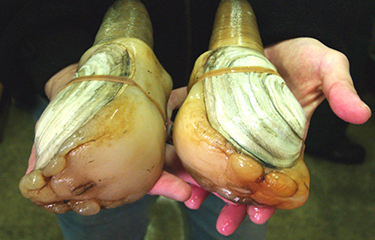Dive fisheries in the U.S. state of Alaska appear to be recovering after COVID-related transportation delays kept live geoducks from getting to key markets in China.
Paralytic shellfish poisoning (PSP) levels, another factor that has limited the supply of giant clams to the market, have been favorable in test samples thus far in 2022.
“This past season went as normal,” Justin Breese, an area management biologist with the Alaska Department of Fish and Game in Ketchikan, Alaska said. The geoduck season for 2021-2022 runs until 30 September. “With every fishery, the supply chain is sometimes the issue, but [product] has been moving.”
The 2022-2023 dive season for geoduck clams opens on 1 October (depending upon PSP levels from test samples) and runs through September 2023, and sea cucumber seasons generally run from 1 October through 31 March of the following year. The seasons also have a weekly schedule conducive to getting samples of geoducks to the lab for PSP testing, allowing the divers to focus on sea cucumbers in the meantime.
“We did a test last weekend [17 September] in one area on the Gravina shoreline that tends to be hot ... and it passed, so that is always good,” Southeast Alaska Regional Dive Fisheries Association Executive Director Kate Sullivan said.
Sullivan said tests for inorganic arsenic, another limiting factor in exporting geoducks, came back negative.
“All our areas passed inorganic arsenic testing for 2022-2023 season, so there are no trade access issues with China regarding that," Sulivan said.
The divers test geoduck beds on Fridays and Saturdays, focus on sea cucumbers on Sundays and Mondays while they wait for PSP test results, and work the geoduck areas on Wednesdays and Thursdays.
“We manage the fishery by the PSP levels,” Breese said.
Alaska divers in the 2020-2021 season landed 562,542 pounds of geoducks, a bit over their guideline harvest level (GHL) of 542,400 pounds. Average ex-vessel prices came in at USD 5.17 (EUR 5.38) per pound and marks the latest in a declining trend in value from a high of USD 10.31 (EUR 10.73) per pound in the 2011-2012 season.
Trade sanctions with China during the 2014-2015 season knocked dockside prices to an average USD 4.56 (EUR 4.74) per pound, and continued tariffs and an economic downturn in the Chinese economy have kept prices at bay in recent years. But last year’s crop of geoducks brought ex-vessel prices of USD 10.00 (EUR 10.40) per pound, according to Sullivan.
The 2022-2023 season for sea cucumbers officially opens on 3 October, with a GHL of 1,962,300 pounds, slightly higher than last year’s 1,872,800 pounds. Divers delivered 99.3 percent of that GHL for average ex-vessel prices of around USD 6.00 (EUR 6.24) per pound, which is significantly higher than the USD 3.58 (EUR 3.72) they received in the 2020-2021 season.
The Southeast Alaska red urchin fishery, meanwhile, has seen steady increases in ex-vessel offers but dwindling harvests in recent years. Divers fished on a GHL of nearly 3 million pounds in the 2020-2021 season, but harvest data has not yet been available. Purple urchin infestations in traditional harvest areas along the West Coast have reduced populations of harvestable red urchins, hence curbing competition for Alaska product, but Japanese markets for uni, the ripened urchin roe remain weak.
In the 2019-2020 season divers harvested 194,000 pounds of a 3.5-million pound quota at USD 0.70 (EUR 0.72). Most recent data from ADF&G shows revenues at just over USD 9,000 (EUR 9,367) per diver.
Reporting by Charlie Ess
Photo courtesy of NOAA







